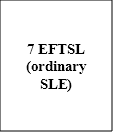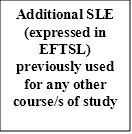Part 1 – Preliminary
1 Name
This instrument is the Higher Education Support (Student Learning Entitlement) Guidelines 2021.
2 Commencement
(1) Each provision of this instrument specified in column 1 of the table commences, or is taken to have commenced, in accordance with column 2 of the table. Any other statement in column 2 has effect according to its terms.
Commencement information |
Column 1 | Column 2 | Column 3 |
Provisions | Commencement | Date/Details |
1. The whole of this instrument | The later of: (a) the start of the day after this instrument is registered; and (b) immediately after the commencement of Schedule 4B to the Higher Education Support Amendment (Job-Ready Graduates and Supporting Regional and Remote Students) Act 2020. | |
Note: This table relates only to the provisions of this instrument as originally made. It will not be amended to deal with any later amendments of this instrument.
(2) Any information in column 3 of the table is not part of this instrument. Information may be inserted in this column, or information in it may be edited, in any published version of this instrument.
3 Authority
This instrument is made under section 238-10 of the Act.
4 Definitions
Note: A number of expressions used in this instrument are defined in Schedule 1 to the Act, including the following:
(a) additional SLE;
(b) Commonwealth supported student;
(c) course of study;
(d) EFTSL;
(e) EFTSL value;
(f) enabling course;
(g) lifelong SLE;
(h) ordinary SLE;
(i) postgraduate course of study;
(j) SLE amount;
(k) undergraduate course of study;
(l) unit of study.
In this instrument:
Act means the Higher Education Support Act 2003.
course load means the minimum aggregated EFTSL value of all of the units of study required to complete the course of study to which those units relate.
Part 2 – Additional SLE
5 Purpose
The purpose of this Part is to:
(a) specify the courses of study, or kinds of courses of study, in relation to which a person has additional SLE (for the purposes of paragraph
73-10(1)(b) of the Act) (see section 6);
(b) specify the requirements a person must meet to have additional SLE (for the purposes of paragraph 73-10(1)(c) of the Act) (see section 6); and
(c) set out how to work out the amount of additional SLE a person has (for the purposes of subsection 73-10(3) of the Act) (see section 7).
6 Specified courses and requirements for additional SLE
(1) A person has additional SLE where they are enrolled in an undergraduate course of study (other than an honours course of study or a graduate entry bachelor degree course of study) and the course load of that course is greater than 6 EFTSL—the amount of additional SLE that a person has in these circumstances is calculated in accordance with subsection 7(1).
(2) A person has additional SLE where they are enrolled in an honours course of study and the course load of that course is less than or equal to 1 EFTSL—the amount of additional SLE that a person has in these circumstances is calculated in accordance with subsection 7(2).
(3) A person has additional SLE where they are enrolled in a postgraduate course of study or a graduate entry bachelor degree course of study and, ignoring paragraph 36-10(1)(d) of the Act, they would be a Commonwealth supported student in relation to a unit of study that forms part of that course—the amount of additional SLE that a person has in these circumstances is calculated in accordance with subsection 7(2).
7 How to calculate the amount of additional SLE
How to calculate the amount of additional SLE a person has for an undergraduate course of study (other than an honours course of study or a graduate entry bachelor degree course of study)
(1) The amount of additional SLE (expressed in EFTSL) a person has for an undergraduate course of study (other than an honours course of study or a graduate entry bachelor degree course of study) that has a course load greater than 6 EFTSL is calculated as follows:




+ – –
How to calculate the amount of additional SLE a person has for an honours course of study, postgraduate course of study or graduate entry bachelor degree course of study
(2) The amount of additional SLE (expressed in EFTSL) a person has for an honours course of study, graduate entry bachelor degree course of study, or postgraduate course of study is calculated as follows:


–
Part 3 – Lifelong SLE
8 Purpose
The purpose of this Part is to:
(a) specify the circumstances in which a person has lifelong SLE (for the purposes of subsection 73-15(1) of the Act) (see section 9);
(b) specify the day on which a person has lifelong SLE (for the purposes of subsection 73-15(2) of the Act) (see section 10); and
(c) set out how to work out the amount of lifelong SLE a person has on the day specified for the purposes of subsection 73-15(2) of the Act (for the purposes of subsection 73-15(3) of the Act) (see section 11).
9 Circumstances in which a person has lifelong SLE
(1) A person has lifelong SLE if the person is or was enrolled in a unit of study as part of a course of study with a higher education provider.
(2) A person has lifelong SLE where:
(a) the person is enrolled in a course of study (other than an enabling course) with a higher education provider; and
(b) the person is a Commonwealth supported student in relation to a unit of study that forms part of the course; and
(c) the provider restructures the course in a manner that will require the person to undertake units of study, in addition to those originally required before the restructure, in order to complete the course.
10 Day on which a person has lifelong SLE
(1) If the circumstances in subsection 9(1) apply to a person, the person has lifelong SLE on the later of:
(a) 1 January 2032; and
(b) the 1 January immediately after the period of 10 years from the date the person first commenced in a unit of study as part of a course of study with a higher education provider.
(2) If the circumstances in subsection 9(2) apply to a person, the person has lifelong SLE on the day the provider restructures the course.
11 Amount of lifelong SLE
(1) The amount of lifelong SLE (expressed in EFTSL) a person has on the day specified in subsection 10(1) is 3 EFTSL.
(2) The amount of lifelong SLE (expressed in EFTSL) a person has on the day specified in subsection 10(2) is an amount that is equal to the total EFTSL value of the additional units of study the person must undertake as a result of the course being restructured in order to complete the course of study.
Part 4 – Reduction of a person’s SLE amount
12 Purpose
For the purposes of subsection 76-1(4) of the Act, this Part specifies how amounts of ordinary SLE, additional SLE and lifelong SLE are to be reduced if a higher education provider reduces a person’s SLE amount at a particular time under subsection 76-1(1) of the Act.
13 Reduction of a person’s amounts of ordinary SLE, additional SLE and lifelong SLE
(1) If a higher education provider reduces a person’s SLE amount at a particular time under subsection 76-1(1) of the Act, the provider must reduce one or more of the person’s ordinary SLE amount, additional SLE amount and lifelong SLE amount to take account of the reduction under that subsection:
(a) in the order specified in subsection (2); and
(b) in accordance with subsection (3).
(2) For the purposes of paragraph (1)(a), the order is:
(a) ordinary SLE;
(b) additional SLE;
(c) lifelong SLE.
(3) For the purposes of paragraph (1)(b):
(a) the person’s ordinary SLE, additional SLE and lifelong SLE amounts must be reduced sequentially by amounts totalling the EFTSL value of the unit of study referred to in subsection 76-1(2) of the Act;
(b) the person’s ordinary SLE amount (if any) must be reduced to zero before the person’s additional SLE amount is reduced;
(c) the person’s additional SLE amount (if any) must be reduced to zero before the person’s lifelong SLE amount is reduced.
Example: Jack is enrolled in his last unit of study as part of a Bachelor of Commerce with a higher education provider. The EFTSL value of that unit of study is 0.75. Immediately before the census date for that unit of study: (a) the amount of ordinary SLE Jack has is 0.25; (b) the amount of additional SLE Jack has is 0.25; (c) the amount of lifelong SLE Jack has is 0.5. To take account of the reduction of Jack’s SLE amount under subsection 76-1(1) of the Act, the provider must: (1) reduce Jack’s ordinary SLE amount to zero; then (2) reduce Jack’s additional SLE amount to zero; and finally (3) reduce Jack’s lifelong SLE to 0.25.
Part 5 – Re-crediting a person’s SLE amount
14 Purpose
This Part specifies how amounts of ordinary SLE, additional SLE and lifelong SLE are to be re-credited if a higher education provider re-credits a person’s SLE amount at a particular time under subsection 79-1(1) or 79-20(1) of the Act (for the purposes of subsections 79-1(2) and 79-20(2) of the Act).
15 Re-crediting of a person’s amounts of ordinary SLE, additional SLE and lifelong SLE
If a higher education provider re-credits a person’s SLE amount at a particular time under subsection 79-1(1) or 79-20(1) of the Act, the provider must re-credit one or more of the person’s ordinary SLE amount, additional SLE amount and lifelong SLE amount to reverse the previous reduction of those amounts under section 13.
Example: Jack enrolled in his last unit of study as part of a Bachelor of Commerce with a higher education provider. The EFTSL value of that unit of study was 0.5. Immediately before the census date for that unit of study: (a) the amount of ordinary SLE Jack had was 0.25; (b) the amount of additional SLE Jack had was 0.25; (c) Jack had no lifelong SLE. In accordance with section 13, to take account of the reduction of Jack’s SLE amount under subsection 76-1(1) of the Act, the provider: (1) reduced Jack’s ordinary SLE amount to zero; and (2) reduced Jack’s additional SLE amount to zero. Subsequently, under subsection 79-1(1) of the Act, the provider re-credits 0.5 to Jack’s SLE amount. To take account of the re-credit under subsection 79-1(1) of the Act and having regard to how Jack’s amounts of ordinary SLE and additional SLE were reduced under section 13 for that unit of study, the provider must re-credit 0.25 to Jack’s ordinary SLE and 0.25 to Jack’s additional SLE.
Part 6 – Special circumstances
16 Purpose
For the purposes of subsection 79-5(2) of the Act, this Part specifies the circumstances in which a higher education provider will be satisfied that circumstances apply to a person that:
(a) are beyond the person’s control (section 17); and
(b) do not make their full impact on the person until on or after the census date for the unit of study in question (section 18); and
(c) make it impracticable for the person to complete the requirements for the unit in the period during which the person undertook, or was to undertake, the unit (section 19).
17 Circumstances beyond the person’s control
(1) A higher education provider will be satisfied that a person’s circumstances are beyond that person’s control if a situation occurs which a reasonable person would consider is not due to the person’s action or inaction, either direct or indirect, and for which the person is not responsible.
(2) The situation referred to in subsection (1) must be unusual, uncommon or abnormal.
18 Circumstances that did not make their full impact until on or after
the census date
A higher education provider will be satisfied that a person’s circumstances did not make their full impact on the person until on or after the census date for a unit of study if the person’s circumstances occur:
(a) before the census date, but worsen after that day; or
(b) before the census date, but the full effect or magnitude does not become apparent until on or after that day; or
(c) on or after the census date.
19 Circumstances that make it impracticable for the person to complete the requirements
(1) A higher education provider will be satisfied that a person’s circumstances make it impracticable for the person to complete the requirements for the unit of study during the period which the person undertook, or was to undertake, the unit if circumstances such as the following occur:
(a) medical circumstances, such as where person’s medical condition has changed to such an extent that they are unable to continue studying; or
(b) family or personal circumstances, such as death or severe medical problems within a family, or unforeseen family financial difficulties, so that it is unreasonable to expect a person to continue their studies; or
(c) employment related circumstances, such as where a person’s employment status or arrangements have changed so that the person is unable to continue their studies, and this change is beyond the person’s control; or
(d) course related circumstances, such as where the provider has changed the unit of study it had offered and the person is disadvantaged by either not being able to complete the unit, or not being given credit towards other units of study or courses of study.
(2) A person is unable to complete the requirements for a unit of study if the person is unable to:
(a) undertake the necessary private study required, or attend sufficient lectures or tutorials or meet other compulsory attendance requirements in order to meet their compulsory course requirements; or
(b) complete the required assessable work; or
(c) sit the required examinations; or
(d) complete any other course requirements because of their inability to meet (a), (b) and (c) above.






